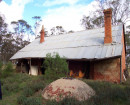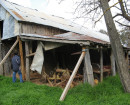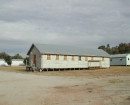RAIL BRIDGE
THOMSON RIVER, WALHALLA AND RAWSON, BAW BAW SHIRE
-
Add to tour
You must log in to do that.
-
Share
-
Shortlist place
You must log in to do that.
- Download report


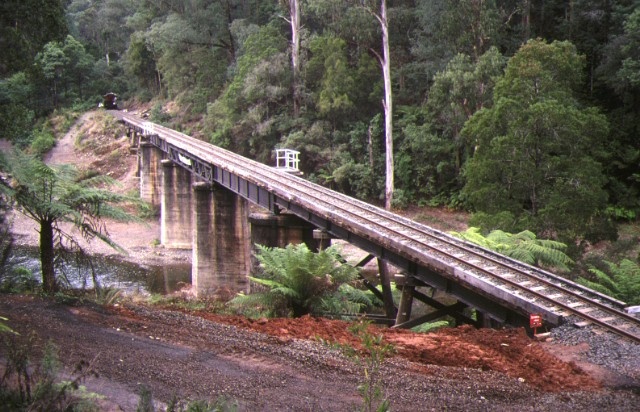
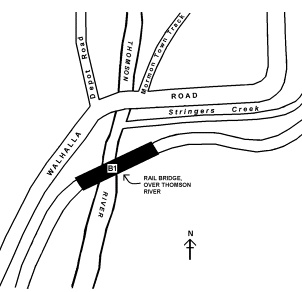
Statement of Significance
What is significant?
Construction of the Rail Bridge, over Thomson River on the Moe to Walhalla Railway was completed late in 1909 and the line was eventually opened through to Walhalla by March 1910. The Moe to Walhalla railway was one of four experimental routes constructed early this century. The lines were intended to develop isolated districts where conventional broad lines incurred prohibitive construction costs. In particular the Moe to Walhalla Railway was constructed to support the gold boom in the area, but ironically this had nearly ceased by the time the railway was built. The necessity to cross the Thomson River some five kilometres south west from Walhalla required the largest single structure on the railway. The Victorian Railways designed a substantial bridge which contained four central concrete piers built into the river bed, the construction of which required temporary diversion of the river. The line was closed in 1954 and re-opened in 1994, to serve as a tourist railway.
The Rail Bridge, over Thomson River is a girder bridge almost 100 metres long and little more than two metres wide. It is comprised of four concrete piers supporting the river spans, as well as five timber trestle piers and two timber abutment piers supporting the approach spans. The approach spans are wrought iron bridge beams which had previously been used in the North Eastern Railway Line. The first and third main river spans are mild steel girders, new at the time of construction. The second river span is a mild steel lattice girder which had previously been used in a bridge at Tocumwal. The bridge remains largely intact and carries a timber deck and single, narrow-gauge rail track over the Thomson River Valley, serving the tourist railway from Thomson to Stringer's Creek Gorge.
How is it significant?
The Rail Bridge, over Thomson River, Walhalla is of historical, social and architectural significance to the State of Victoria.
Why is it significant?
The Rail Bridge, over Thomson River, Walhalla is of historical and social importance for its role in connecting the gold mining town of Walhalla with Moe and Melbourne after Walhalla had been isolated by distance and topography for most of its productive years. It also serves as a reminder of the expense incurred to build a railway in anticipation of the successes from the gold mining area, which never eventuated. The line's re-opening in 1994 as a tourist railway is of social importance in demonstrating the interest historic railways generate in the community.
The Rail Bridge, over Thomson River is of architectural importance as the largest structure built on the narrow gauge lines and is representative of railway engineering practice of the early twentieth century. It serves as a reminder of the difficult engineering achievements involved in spanning the wide crossing over the Thomson River at an isolated location. The bridge is important as a significant section of the Moe to Walhalla line which, clinging to sheer slopes and spanning thirteen bridges beyond Erica, attracted international attention as a minor masterpiece of innovative engineering. The bridge is of architectural importance for its unusual construction type, using a combination of structural materials including recycled mild steel girders and a lattice girder as well as concrete piers, timber trestle piers and timber abutment piers.
-
-
RAIL BRIDGE - History
Contextual History:History of Place:
The deep underground mines at Walhalla produced large tonnages of gold over a fifty year period from 1865 to 1915 and the former Long Tunnel Mine still holds the position of the richest gold mine in the State of Victoria. By the end of the nineteenth century the town possessed a population of 3000 and was one of the largest towns in Gippsland, but remained dependant on pack horses for virtually all its supplies. Boilers from the mines consumed vast amounts of firewood which eventually denuded the area around the town of all timber. A large network of light tramways kept the supplies of timber available, and by the late 1880s the town’s Shire Council and influential mining interests had begun strong representations to the Colonial Government for a rail connection to the main Gippsland line, some forty kilometres to the south .
HISTORY OF PLACE :
The Moe to Walhalla railway was one of four experimental routes constructed early this century which were intended to develop isolated districts where conventional broad lines would incur prohibitive construction costs. With the exception of the renowned “Puffing Billy” route in the Dandenong Ranges close to Melbourne the other lines have long been abandoned.
After years of delays, political obstruction and surveys, construction of the line commenced in 1904 and was built in stages as funds permitted until it finally reached Walhalla in 1910. By this time the mines were rapidly declining with large scale activities ceasing in 1914. The town dramatically scaled down in size during World War 1. Although construction of the line as far as Erica was reasonably straightforward, the final fifteen kilometres into Walhalla provided some of the most challenging engineering difficulties ever encountered in railway construction in Victoria. Clinging to sheer slopes and spanning thirteen bridges beyond Erica, the line attracted international attention as a minor masterpiece of innovative engineering.
The necessity to cross the Thomson River some five kilometres south west from Walhalla required the largest single structure on the railway. As the river had always been subject to significant loading, it was necessary to ensure that it could resist the highest known flood levels. Accordingly, the Victorian Railways designed a substantial bridge which contained four central concrete piers built into the river bed, the construction of which required temporary diversion of the river.
The ends of the piers facing the river flow were pointed to deflect any debris carried downstream.
The concrete piers carried three steel girders, two recycled from the main Albury line and another which had spanned the Murray River at Tocumwal. The girders were converted from the wider broad gauge width to narrow gauge at the Victorian Railway workshops at Newport and were railed to Moe, where they were transhipped to the narrow gauge line.
The approaches to the main steel girders were supported by timber trestles at both ends of the bridge, with the entire structure having a length of 300 feet. Construction of the bridge was completed late in 1909 and the line was eventually opened through to Walhalla by March 1910.
Large scale mining activity concluded in Walhalla by the start of World War 1 and rail traffic on the line gradually declined to almost non existent levels by the early 1930s although some numbers of tourists were carried on excursion trains in the last few years of operations. The line was closed from Walhalla to Platina in April 1944, with the remainder of the railway being closed in sections over the next decade.
After the line was dismantled between 1958-1962 a number of bridges escaped demolition, but most have gradually succumbed to the effects of neglect and the harsh environment.
The Rail Bridge, over Thomson River remains almost fully intact and was legally vested
COMPARISON:
The Rail Bridge over Thomson River can be compared with the Railway Trestle Bridge over Monbulk Creek, Selby which was also built on a narrow gauge line. The type of construction is different however as the Monbulk Creek Bridge is a timber trestle bridge. There are other rail bridges using steel girders however, no others use the same combination of materials. The Thomson River Rail Bridge is unique as an engineering achievement for its position and as part of a narrow gauge line.
Other examples of iron/steel rail bridges
H1692, Rail Bridge over Jacksons Creek North of Rupertswood, Sunbury, 1861, 1917, Metal girder, stone abutments and piers,
H1432, Rail Bridge over Creswick Creek, Creswick-Clunes Line, Creswick, 1874, Iron Bridge,
H1197, Rail Bridge (Albion Viaduct), Albion/Jacana, 1927-29, steel girders, steel frame towers
H1427, Bridge over Maribyrnong River, Keilor, 1868, iron bridge with girders,
1448, Queens Bridge, Queensbridge Street, , Melbourne, 1887-90, iron plate and cylinder,
H994, Sandridge Railway Line Bridge over Yarra River, Melbourne, 1886-88, Steel Girder,
H1105, Railway Viaduct over the Moorabool River, Ballarat-Geelong Line, Moorabool, 1862, 1918, 1983, bluestone piers, metal trusses replaced with steel girders,
H1444, Tramway Bridge, Poverty Point , Walhalla, 1900, prefab steel girders and tubular steel struts,
H1213, Rail Bridge over Maribyrnong River, Footscray, 1858-1859, 1911, iron, steel , bluestone abutments,
H1061, Rail Bridge over Broken River, Benalla, 1879, cylindrical iron piers, wrought iron girder,
the Shire of Narracan by an Act of Parliament in 1962. Although it has received no maintenance in almost half a century, its condition is basically sound, although the timber trestles at each approach are in poor repair. In 1994 the line was opened again for tourist services.RAIL BRIDGE - Permit Exemptions
General Exemptions:General exemptions apply to all places and objects included in the Victorian Heritage Register (VHR). General exemptions have been designed to allow everyday activities, maintenance and changes to your property, which don’t harm its cultural heritage significance, to proceed without the need to obtain approvals under the Heritage Act 2017.Places of worship: In some circumstances, you can alter a place of worship to accommodate religious practices without a permit, but you must notify the Executive Director of Heritage Victoria before you start the works or activities at least 20 business days before the works or activities are to commence.Subdivision/consolidation: Permit exemptions exist for some subdivisions and consolidations. If the subdivision or consolidation is in accordance with a planning permit granted under Part 4 of the Planning and Environment Act 1987 and the application for the planning permit was referred to the Executive Director of Heritage Victoria as a determining referral authority, a permit is not required.Specific exemptions may also apply to your registered place or object. If applicable, these are listed below. Specific exemptions are tailored to the conservation and management needs of an individual registered place or object and set out works and activities that are exempt from the requirements of a permit. Specific exemptions prevail if they conflict with general exemptions. Find out more about heritage permit exemptions here.Specific Exemptions:EXEMPTIONS FROM PERMITS:
(Classes of works or activities which may be undertaken without a permit under
Part 4 of the Heritage Act 1995)
General Conditions
1. All exempted alterations are to be planned and carried out in a manner
which prevents damage to the fabric of the registered place or object.
2. Should it become apparent during further inspection or the carrying out of
alterations that original or previously hidden or inaccessible details of the
place or object are revealed which relate to the significance of the place or
object, then the exemption covering such alteration shall cease and the
Executive Director shall be notified as soon as possible.
3. If there is a conservation policy and plan approved by the Executive
Director, all works shall be in accordance with it.
4. Nothing in this declaration prevents the Executive Director from amending
or rescinding all or any of the permit exemptions.
5. Nothing in this declaration exempts owners or their agents from the
responsibility to seek relevant planning or building permits from the
responsible authority where applicable.
* No permit required for routine maintenance of Rail Bridge, over Thomson Rive
* No permit required to replace like with like on Rail Bridge, over Thomson
River
-
-
-
-




